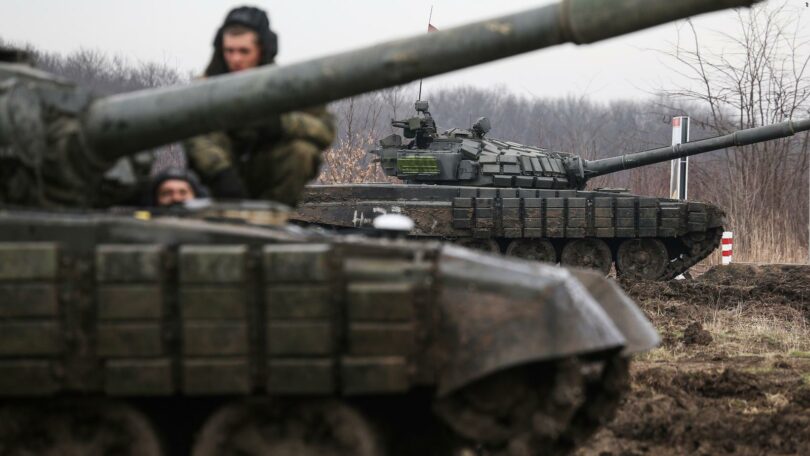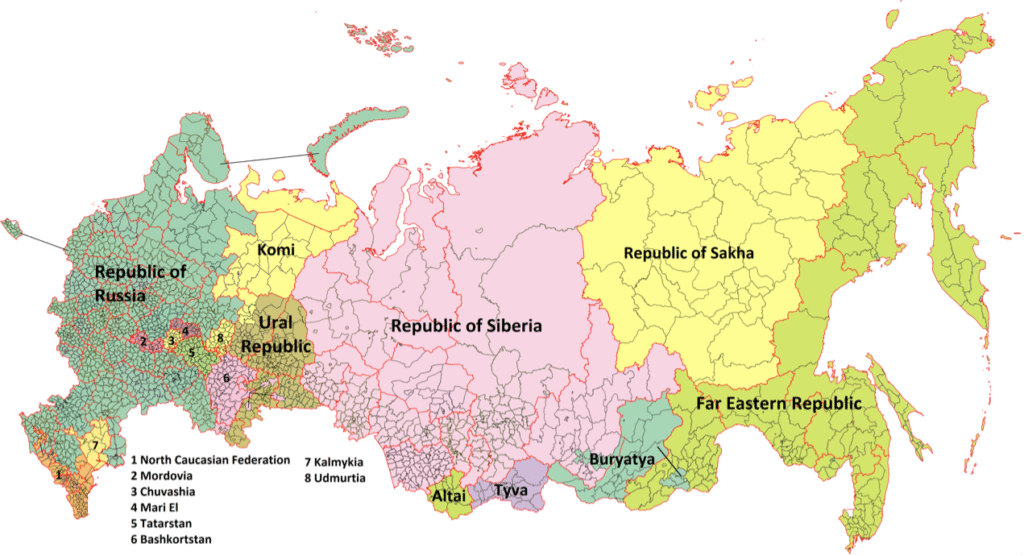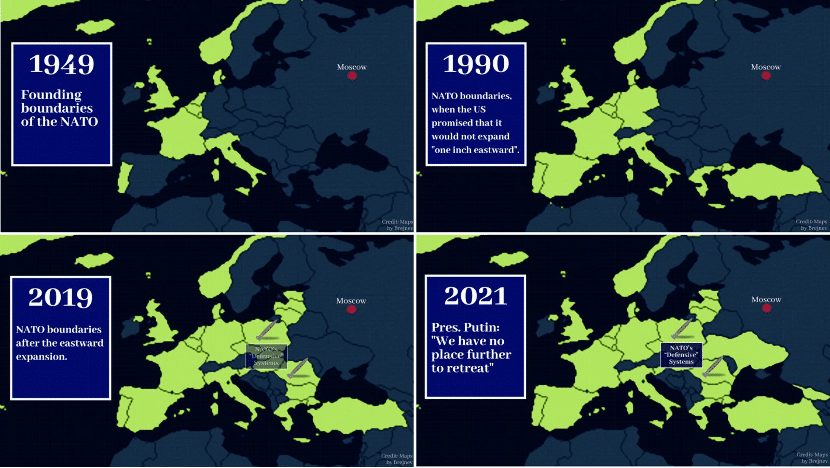This was originally written for a Chinese audience and adapted and published in Guancha. —Eds.
Russian President Vladimir Putin’s recognition of the Donetsk and Luhansk People’s Republics on 21 February means that tensions in Eastern Ukraine are likely to continue to rise, which is exactly what U.S. foreign policy wants to promote. Three days ago, Foreign Policy published an article on its website titled “Washington Must Prepare for War with Both Russia and China.” According to the article,
The United States remains the world’s leading power with global interests, and it cannot afford to choose between Europe and the Indo-Pacific. Instead, Washington and its allies should develop a defense strategy capable of deterring and, if necessary, defeating Russia and China at the same time.
Matthew Kroenig, the author of this article, is from the Scowcroft Center for Strategy and Security-Atlantic Council, which published the Longer Telegram last year and advocated for comprehensive containment of China. As a key U.S. defense think tank, this article by the Scowcroft Center reflects the current mainstream U.S. diplomatic and military view of China and Russia, to which China should pay attention.
Fighting two wars at the same time
According to Kroenig’s article, “A major war in Ukraine may cross international borders and threaten the seven NATO allies bordering Russia, Belarus, and Ukraine…while other vulnerable Eastern European countries, Poland, Romania, or the Baltic states, may be the next target”, despite the fact that both Russia and Ukraine have stated that they have no desire in starting a war. Philip Davidson, a former commander of the U.S. India-Pakistan Command, was quoted in the article as saying that “China may invade Taiwan within the next six years…If China succeeds in gaining control of Taiwan, it will continue to undermine the American-led Asian order”. The U.S. feels threatened by the vacillation of its “global security commitment” with these possibilities.
In the eyes of the U.S., China and Russia are the two most important adversaries: their vast territory, long history, profound national culture, and strategic nuclear weapons are all threats to American global hegemony. According to the U.S., the only way to eliminate the threat is that the two great powers’ submit to U.S.’ global hegemony. As regards Russia, which has yet to recover from its weakness, the U.S. hopes to completely dismantle it and destroy its nuclear weapons, causing it to lose all global influence. As regards China, which has a more united people, a more stable ruling party, and a healthier economy, the U.S. hopes to overthrow its leaders through a “color revolution” and gradually erode the Chinese people’s faith in communism. Maintaining military containment of both countries is, in Kroenig’s view, a non-negotiable premise.
“The U.S. will not be forced to make distressing strategic choices about its national security due to limited resources”, Kroenig asserted. In order to support “defeating Russia and China in overlapping timeframes”, Kroenig proposes that the U.S. increase its defense spending. At market prices, although not in real terms, measured in purchasing power parities (PPPs) the U.S. accounts for 24% of global GDP, while China and Russia together account for only 19%. Against the backdrop of the recent withdrawal of U.S. troops from Afghanistan, Kroenig not only argues against any cuts to military spending, but to double it to 5.6% of U.S. GDP, close to the percentage of the GDP spent on defense during the Cold War, because “this new Cold War is just as dangerous as the last one”.
Another proposal is to include U.S. “key allies in military planning, sharing responsibilities, and streamlining the division of labor for weapons procurement”. With the U.S. and its formal treaty allies accounting for nearly 60% of global GDP, Kroenig suggests that the U.S. supplement existing alliances (e.g., NATO, bilateral alliances in Asia) with new arrangements like the Quadrilateral Security Dialogue (QUAD) to “more easily mobilize resources and maintain military superiority over China and Russia”. He suggested that U.S. European allies invest in armor and artillery, while Asian allies purchase mines, harpoon missiles, and submarines, and the U.S. Army prioritizes Europe while the U.S. Navy handles the Indo-Pacific.
Kroenig finally put nuclear weapons on the table. “Relying more on nuclear weapons to offset our adversary’s local conventional advantage [is necessary]”, he states. He goes on to explain that “The U.S. can rely on threatening non-strategic nuclear strikes as a deterrent and as a last resort to thwart China’s amphibious invasion of Taiwan or Russia’s tank invasion of Europe”.
A continuation of decades of strategy toward Russia
The current U.S. policy towards Russia is not a blip on the radar, but a continuation of a decades-long Cold War strategy. In 1972, shortly after Kissinger’s secret visit to China, he told President Nixon that the Chinese were “just as dangerous as the Russians, and even more dangerous in certain historical periods”. He hoped that Washington could take advantage of Moscow and Beijing by playing “an unemotional balance of the power game”. In Kissinger’s view, 20 years later, the U.S. would lean towards Russia to restrain China, if it could first use China to weaken the Soviet Union. Subsequent U.S. administrations (both Democrat and Republican) followed through on this strategy, working with China and weakening the Soviet Union, hastening its collapse.
But the collapse of the Soviet Union in 1991 did not fully satisfy the U.S. During Yeltsin’s administration, the U.S. failed to persuade Russia—like Ukraine, Belarus, and Kazakhstan—to give up its nuclear weapons altogether. After the U.S. withdrew from the 1972 ABM Treaty in 2001, Russia also withdrew from the START II Treaty. At this time, Russia still deployed more than 5,000 strategic nuclear warheads and maintained a strong influence in Eastern Europe. The goal of the U.S. is to further weaken or destroy Russia economically, destabilize its politics, confuse the Russian people, and eventually dismantle Russia into smaller countries, and most importantly, eliminate its nuclear arsenal.
Washington, however, underestimated the patriotic sentiments of the Russian people. Historically, Russia has suffered many invasions by Western European countries, including Napoleon’s invasion of Russia in 1812, the 14-state alliance’s armed intervention in the nascent Soviet regime in 1918, and the German fascist invasion of the Soviet Union during World War II, which resulted in tens of millions of military and civilian casualties. The Soviet Union and China made the greatest sacrifices in the world war against fascism, shaping strong nationalism and patriotism in both countries at the same time. Patriotism became the most important factor influencing Russian politics, and every political party was judged by how they defended their country. Especially after the difficult period following the collapse of the Soviet Union, the Russian people today are not as easily deceived as the U.S. might expect, and President Vladimir Putin has always enjoyed a high approval rating. Despite prolonged U.S. economic sanctions and domestic “color revolutions,” the Russian regime has remained stable for a long time. Eventually, the U.S. decided to escalate tensions in Ukraine on its own initiative, imposing the threat of war on the people of Eastern Ukraine and forcing Russia to defend itself, thus finding a pretext to launch a larger round of hybrid war and economic sanctions against Russia.
Contrary to Kroenig’s alarmist remarks in his article, Russia never claimed invasion amidst the Eastern Ukraine tensions, but complete self-defense. Donetsk and Luhansk, the two affected regions, have, historically, closer ties to Russia than to Ukraine. In the mid-18th century, Tsarina Ekaterina II developed the area into an industrial town, renamed it “New Russia” and migrated a large number of ethnic Russians to the land. Western Ukraine was occupied by Lithuanians, Poles, Austrians, Russians, and Germans for centuries, thus different from Russia ethnically, linguistically, and religiously. Its inhabitants have a lower sense of identity and even deep hostility towards Russia. In recent years, neo-Nazi forces have grown stronger in Western Ukraine, as exemplified by torchlight parades in cities like Kyiv and Lviv to commemorate the birth of Stepan Bandera, a Nazi leader. During the previous conflicts, ultra-nationalists in Western Ukraine raised Nazi banners and threatened to kill all Eastern Ukrainians and pro-Russians. Ethnic Russians in Eastern Ukraine had to organize resistance and seek assistance from Russia. Public opinion in Russia also agreed that Putin should help their Russian compatriots in the Eastern Ukraine region.
NATO’s eastward expansion has pushed the security issue in Ukraine to a boiling point. Prior to the collapse of the Soviet Union, the U.S. promised Mikhail Gorbachev that NATO would not expand eastward because its original mission—to confront the Soviet Union and contain communism in Europe—had come to an end when the Cold War ceased. However, NATO reneged on this “gentleman’s agreement” after the Cold War by adopting 14 more member countries, including some former members of the Soviet Union. In 2018, Ukraine amended its constitution to make attaining NATO and EU membership its primary national strategy, which posed a serious threat to Russia’s national security. As Kyiv, Ukraine’s capital, is only 760 kilometers in a straight line from Moscow, giving permission to NATO to deploy ultra-high-sonic nuclear weapons in Ukraine would almost certainly mean the total military surrender of Russia.
After the end of the Cold War, the driving forces behind U.S. diplomatic strategy have gone beyond the containment of communism, coveting unquestionable and permanent hegemony in the military and economic arenas. In the strategic vision of the U.S., Russia should be disarmed to become part of Europe as a “sidekick” and a bridgehead to contain China, the “more dangerous enemy” as Kissinger described it. But the Russians’ history and current international status have made it unacceptable for them to be a “sidekick” to follow a U.S.-led Europe. Moreover, Putin is already suspicious of U.S. credibility in international affairs. There is no question that the Russian government had no desire in starting a war, not only because of the inevitable U.S. and Western European economic sanctions, but also because Putin does not want to put China in a dilemma. The tension in Eastern Ukraine today is a microcosm of U.S.-Russian relations: the U.S. is pressing forward, and Russia has no space to retreat.
Consensus of U.S. elite
When the Atlantic Council’s Scowcroft Center for Strategy and Security released its report The Longer Telegraph last year, Chinese intellectuals accurately pointed out that the report was rife with antiquated worldviews, outdated methodologies, and poor-quality content. However, this does not mean that this report, and Kroenig’s recent article, should not be taken seriously by China.
In the field of U.S. foreign policy, the Council on Foreign Relations (CFR), the Atlantic Council, and the Center for a New American Security (CNAS) are three of the most important U.S. think tanks, and all three consistently adopt a Cold War perspective on China and Russia. The CFR, the most influential in the diplomatic field, has produced an eye-opening timeline of “U.S.-China Relations: 1949-2021,” in which the vast majority of nodes reveal confrontation rather than—as many Chinese scholars would have it—friendly cooperation. CNAS was founded in 2007 when the U.S. political elite began to realize that China’s future leaders would not be the next Gorbachev or Yeltsin, and therefore needed to “design a path for U.S. engagement with China…to encourage a more responsible Chinese regime”—a euphemism for “containment” or “color revolution.” During the subsequent Obama term, CNAS played a key role in the Asia-Pacific rebalancing strategy. As for the Atlantic Council, which is mentioned several times in this article, it is a direct supporter of U.S. military hegemony. In the recent conflict in Eastern Ukraine, this think tank was the first to predict that Russia would “invade” Ukraine. The Atlantic Council has been involved in the war in Afghanistan, the Jasmine Revolution in North Africa, and the “Occupy Central” movement in Hong Kong. These think tanks are deeply integrated with the traditional military-industrial complex, forming a complete chain of inciting, manufacturing, and implementing hybrid warfare.
Despite the current deep bipartisan divide in the U.S., there is a high degree of agreement on foreign policy: Russia must be weakened and dismembered; China is the greatest threat to U.S. imperialist hegemony. While the U.S. economy has not recovered from the 2008 Financial Crisis and has recently been hit by the pandemic, China’s remarkable performance in these two rounds of global disasters makes it a strong challenger to U.S. economic hegemony. In purchasing power parity terms, China’s GDP has surpassed that of the United States in 2013; even in market exchange terms, China’s GDP will surpass that of the United States in 2028. The U.S. political elite is well aware that it will be difficult to defeat and contain China economically, so they have every incentive to resort to hybrid wars (including economic sanctions, legal wars, propaganda wars, etc.) and even hot wars to maintain U.S. hegemony.
John Bellamy Foster of the Monthly Review points out that the United States faces many intractable internal conflicts today, and that Trump, elected to the presidency by disaffected Americans, represents not populism but a brutal, war-hungry neo-fascism. And Biden and the Democratic Party have no contradiction with the Republican Party on the point of being anti-Russian and anti-Chinese. Pompeo, who served as secretary of state in the Trump administration and is likely to run for President in 2024, is a more rational and efficient neo-fascist, ready to plot a war in Taiwan; he will reportedly visit Taiwan this March to meet with “President” Tsai. It looks like he is already pushing the Atlantic Council’s proposed strategy of “defeating Russia and China in overlapping timeframes”.
The U.S. political elite may seem foolish and arrogant compared to China’s governance model of “selecting the noble and appointing the capable,” but our friends in China need to understand that these political elites have the will, resources, and power to wage two wars against China and Russia at the same time and are not afraid to use nuclear weapons. Their danger is not lessened by their stupidity and arrogance. Many Chinese still regard Nixon and Kissinger as “old friends of the Chinese people” after even 50 years since President Nixon visited China. But the reality is that relations between China and the United States are entering a long, cold winter, and the American political elite is already in cold war mode and are ready for a hot war.



